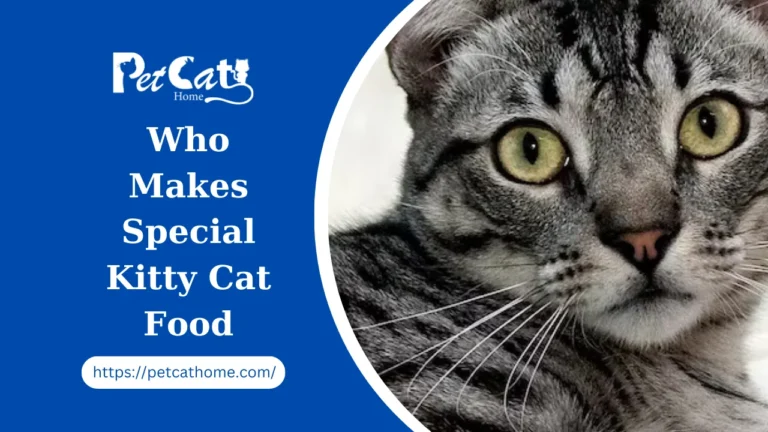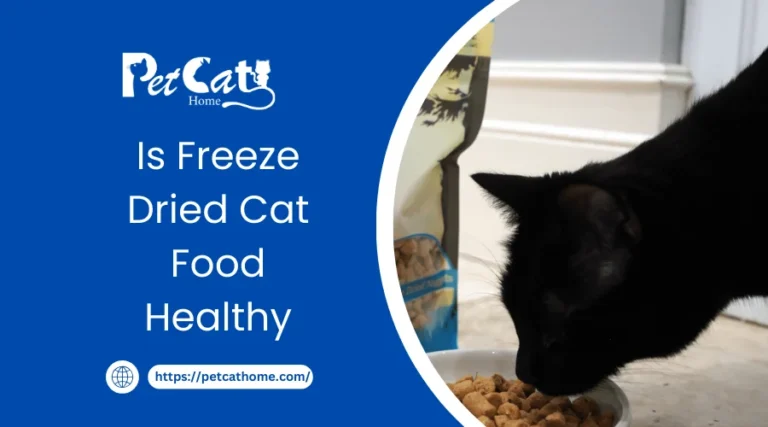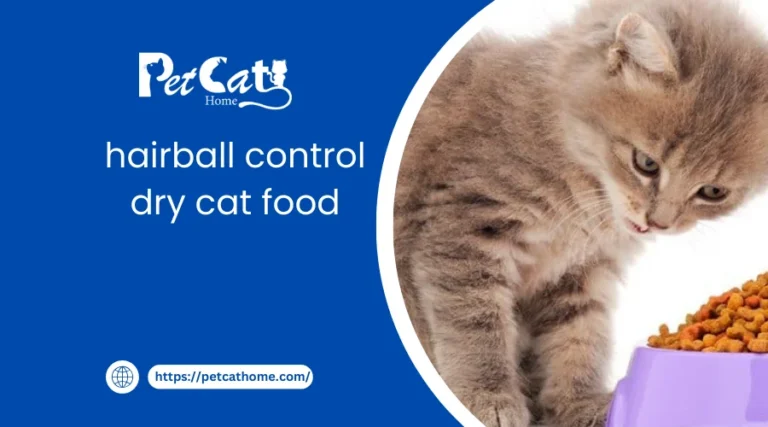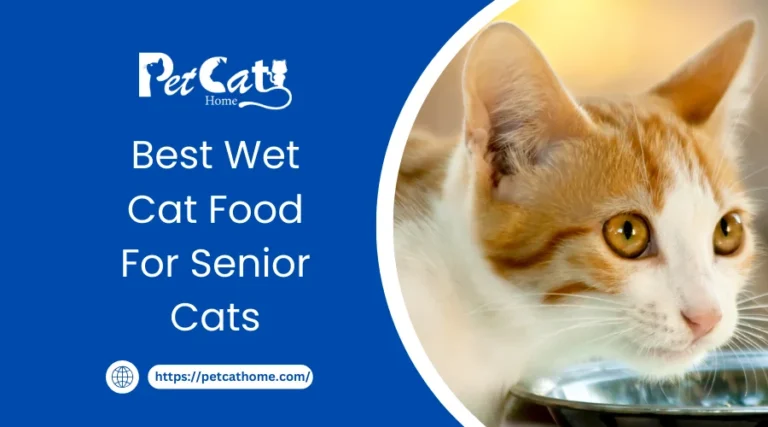Best Cat Food For Urinary Health Without Vet Prescription
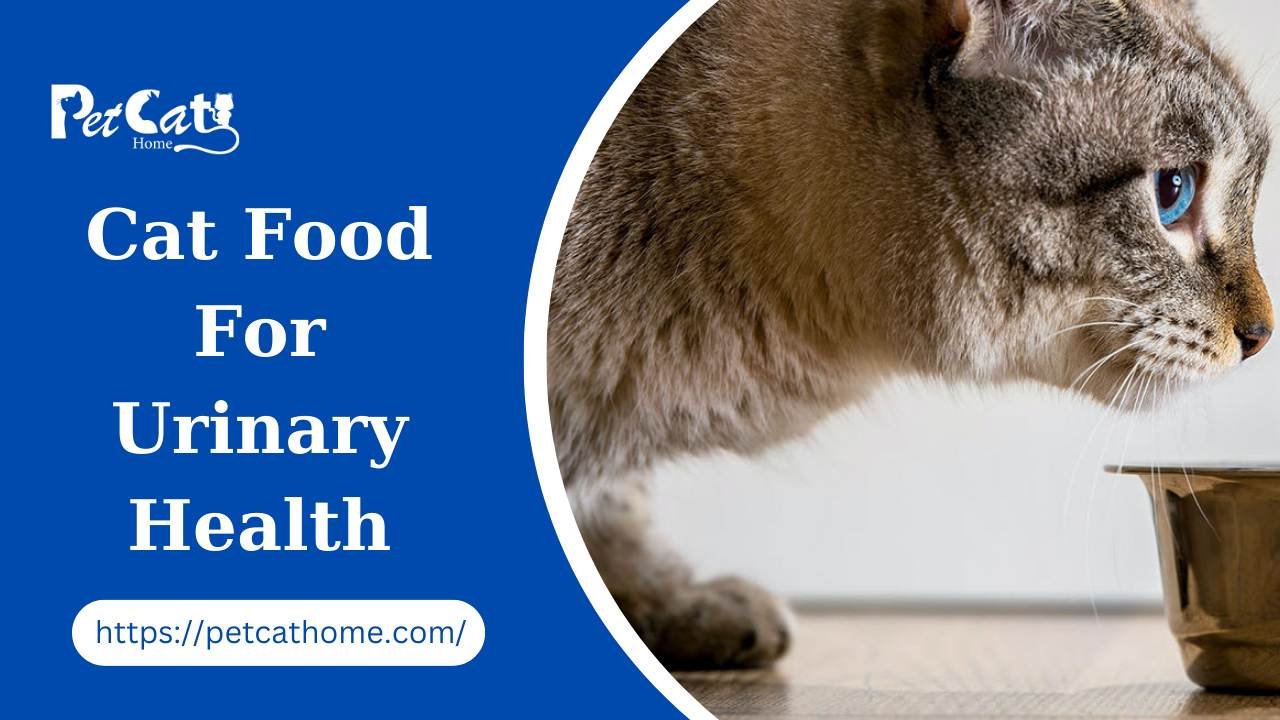
Giving your feline companion the greatest nourishment possible is an important part of cat care, particularly when it comes to urinary wellness. It can be difficult to get the best cat food without a prescription from a veterinarian. It is, however, attainable with the appropriate direction. For the sake of your cat’s well-being, this resource provides reviews, insights, and professional guidance to help you make an informed choice.
Understanding Feline Urinary Health
The general health of your cat depends on the condition of their urine. It’s critical to recognize the role that a healthy diet, enough water, and the right nutrients play in preventing urinary tract problems.
The Impact of Diet on Urinary Health
The urine health of a cat is directly influenced by its food. Diets high in calcium, phosphorus, or magnesium may aggravate urinary tract issues. Top Cat Food For Healthy Urinary System Without A Vet To support urinary tract health, the prescription emphasizes low mineral content, high moisture content, and a regulated pH level.
The Role of Water Intake
Top Cat Food For Healthy Urinary System Without A Vet Wet food is frequently prescribed to encourage drinking more water. Because it dilutes the minerals in the urine, water is essential for preventing urinary tract problems.
Choosing the Right Cat Food
For urinary health, choosing the best cat food is essential without a prescription from a veterinarian.
Ingredients to Look For
- Cranberries: Well known for their advantages to the urinary tract.
- Chicken Turkey: chicken are excellent protein source that is low in magnesium.
- Omega-3 Fatty Acids: Well-known for their ability to reduce inflammation.
Avoiding Harmful Additives
Avoid feeding your cat anything with artificial flavourings, colours, or preservatives. These additions may make urinary issues worse.
The 8 Best Cat Foods for Urinary Tract Health in 2024

Urinary tract health, which encompasses disorders affecting the bladder and/or urethra, is a common issue faced by many house cats. Urination difficulties and pains, increased frequency of urination, and/or blood in the urine are some symptoms of this. Cats can urinate in bathtubs, sinks, corners, and even outside the litter box. While these problems can arise in cats of any age, middle-aged, overweight cats who don’t get enough exercise are frequently the ones who exhibit them.
The food a cat eats can either worsen or contribute to urine pH imbalance. Dr. Danielle Bernal, Global Veterinarian with Wellness Natural Pet Food, says, “Diets can vary in how they support urinary tract health, but it’s important to look for restricted amounts of minerals, such as magnesium and phosphorus, which can contribute to the development of urinary crystal and stone formation.” Both passing the stones and urinating with the crystals hurt. They could result in kidney issues, obstructions, or urinary tract infections.
To prevent crystal formation, animal nutritionists usually create recipes that encourage a more acidic pH urine concentration. Furthermore, wet diets particularly benefit urinary health by increasing hydration, which helps to lessen concentration.
One of the biggest things we can do to provide your cat with better comfort, long-term health, and lifespan is to feed them a high-quality diet designed with their urinary system health in mind. Generally speaking, choose foods that are low in magnesium and high in moisture. Consider the kind and caliber of the ingredients, as well as if they are local, organic, or have any other certifications. As long as the meal doesn’t include a lot of carbohydrates, such as potatoes and peas, “grain-free” foods are usually preferable for cats with urinary tract problems.1.
Best Overall: Ev anger’s EVx Restricted: Urinary health Tract
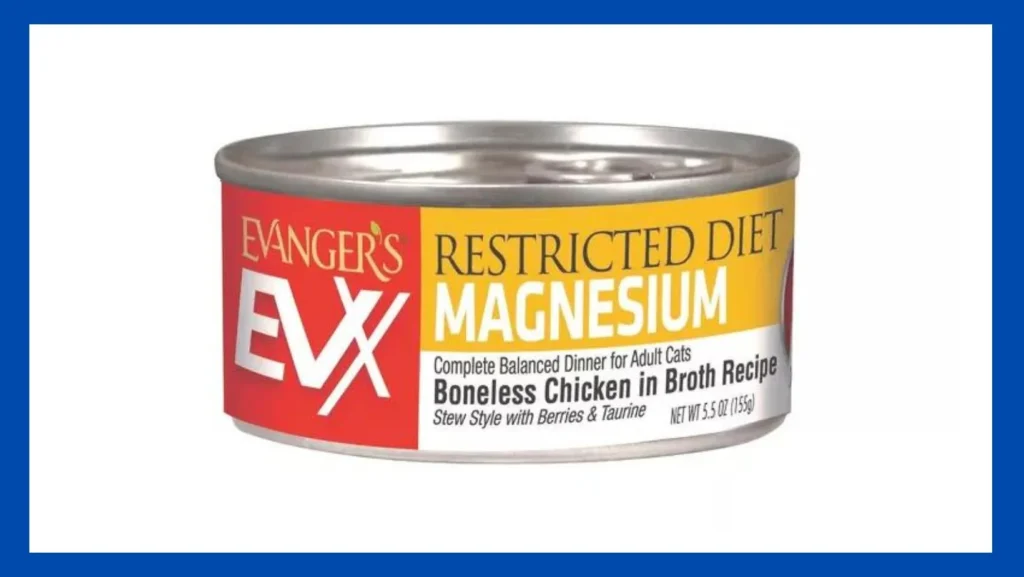
For cats who are prone to urinary struvite crystals and urinary pH imbalance, Evanger’s EVx Restricted Diet Urinary Tract Recipe is a perfect solution. These ingredients, which were created in consultation with nutritionists and specialists, are basic, easily recognized, and developed following AAFCO guidelines for all life stages.
Produced in Markham, Illinois, this meal consists of just a few primary ingredients (boneless chicken, tomato paste, cranberries, and blueberries), as well as three unique ingredients and necessary vitamins and minerals. To avoid bladder stones and struvite crystals, Alltech Acid Balance lowers the pH of the urine. Alltech NVGEN is a supplement that feeds the gut nutrients called postbiotics that it isn’t currently producing well on its own. It is made from yeast and yucca extracts. Additionally, lactogen—a concoction of yeast, chicory root, and yucca—supports a healthy digestive system.
It is grain- and gluten-free and has added omega-3 and -6 fatty acids to nourish skin and fur. A bonus is that the steel cans are confirmed bisphenol-A (BPA)–free with labels printed on recycled paper. Although this recipe is not kosher, for those requiring a kosher diet for their cat, Evanger’s offers more than 40 recipes endorsed by the Chicago Rabbinical Council as kosher for cats.
The family-run business Evanger’s Canned Pet Food has a long history of promoting a better diet for animals.
Important Ingredients: Alltech Acid Balance, tomato paste, boneless chicken, blueberries, and cranberries Serving size: half a can (62 calories) | Balance: minimum 9% protein, minimum 5% fat, maximum 1% crude fiber, maximum 82% moisture | Life stages: All | Texture: Boneless chicken chunks in gravy
Best Wet: Hill’s Prescription Diet c/d Multicare Urinary Health Care with Chicken Canned Cat Food
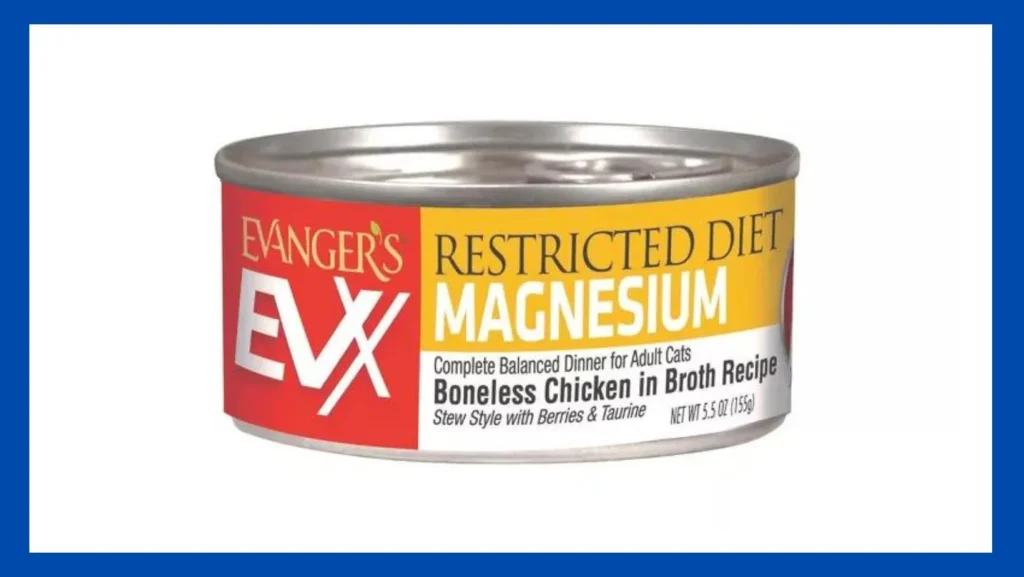
Hill’s Prescription Diet c/d Multicare Urinary Health Care is a wet cat food that was created especially to assist a cat’s urinary health by nutritionists and veterinarians. According to research, Hill’s c/d Multicare can reduce the recurrence of the majority of frequent urinary symptoms by 89%. Additionally, they assert that the danger of developing struvite and calcium oxalate stones has decreased and that struvite stones have dissolved in some cats in as little as seven days, on average, 27 days.
Both the food’s label and the ingredients themselves are easily recognized. Pork liver, carrots, chicken, tuna, rice, spinach, chicken fat, and fish oil—a source of omega-3 fatty acids—are among the best ingredients. In addition to being rich in essential vitamins and minerals, the proportions of calcium, phosphorus, and magnesium are regulated to avoid crystal formation. There is a stew flavor made with vegetables and chicken available for this brand.
Moreover, Hill’s has demonstrated its commitment to sustainability by earning the Total Resource Use and Efficiency (TRUE) Certification. They have also long been involved in other shelter support initiatives.
Key Ingredients: Pork Liver, Carrots, Chicken, Tuna, Wheat Gluten, Rice, Spinach, Fish Oil, and Chicken Fat. Per Serving: 82 Calories (half a can) with a Balance of at least 8.5% Protein, 3.5% Fat, and 2.0% Crude Fiber. Rice-sized bits in a light gravy. Life stage: Adult and elderly cats.
Best Dry: Wysong Uretic Dry Cat Food
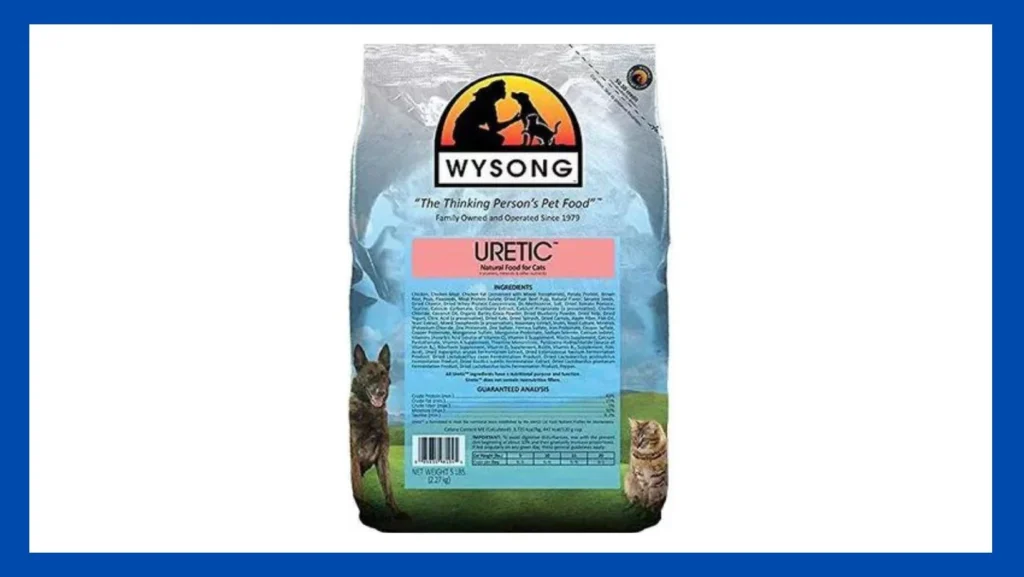
You can know Wysong has put a lot of science and consideration into their Uretic dry cat food formula—which they have been developing for more than 30 years—by reading the box for this brand. Veterinarian-created, food’s nutritional composition addresses immunological, urinary, and overall health holistically. The Uretic dry recipe, which was most recently modified in the Fall of 2020, has larger amounts of protein, fat, and fresh, frozen, and dried meats and organs. The dish is cooked using chicken that is imported from the United States, and cranberry extract is added to assist in reducing the pH of urine.
Wysong is also aware of the micronutrients and nutraceuticals that are present in food, such as enzymes, antioxidants, probiotics, and omega-3 fatty acids. Methionine, which encourages urine acidity, has also been introduced. In addition, tiny amounts of fruits and vegetables have been introduced to simulate what prey’s bellies would contain.
Make sure your cat always has access to plenty of water when giving them only dry food. Recently, Wysong unveiled a moist uremic canned meal that shares comparable components and formulation.
Key Ingredients: Chicken, chicken a meal or chicken fat, potato the protein, brown rice, peas, the ones from flax cranberries as extract, prebiotics, probiotics via Calories per serving: 164 (50 g) | Balance: The crude Protein min. 42%, The crude Fat min. 15%, Crude dietary fiber max. 5%, The water max. 10%, Taurine min. 0.2% All life stages | Texture: Dried x-shaped fragments
Best Budget: IAMS PROACTIVE HEALTH Adult Urinary Tract Health Dry Cat Food with Chicken
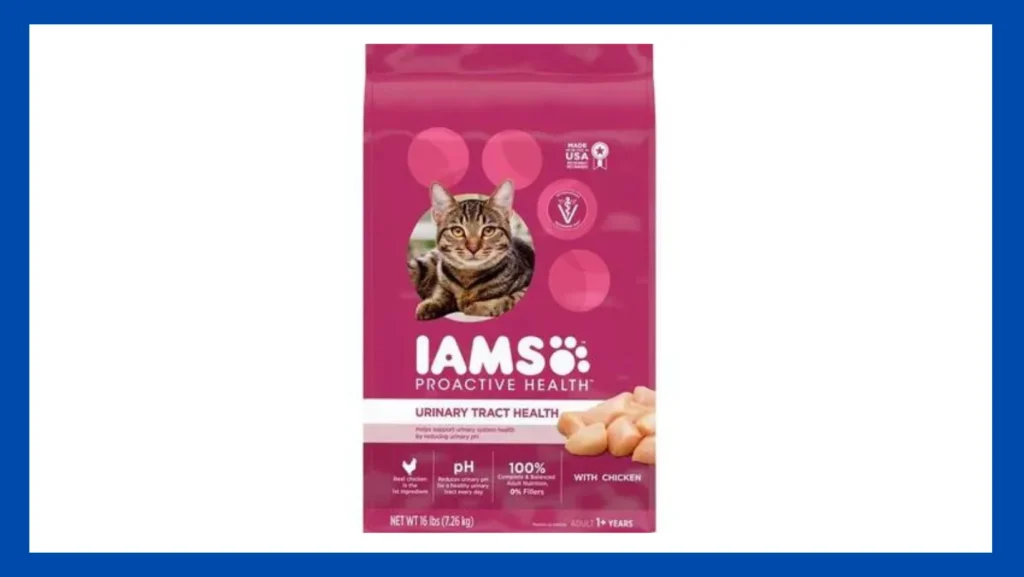
Your cat doesn’t have to suffer any longer if you’re on a tight budget. IAMS Proactive Health Adult Urinary Tract Health Dry Cat Food has a competitive price point despite not being the least-priced product on the market because it is highly regarded and easily accessible.
The primary component in this dish is chicken. For many less expensive foods, that isn’t the case. In addition, extra omega-3 and -6 fatty acids and vitamin E are added for strong immunity and good skin, respectively. The majority of cats, even the pickiest ones, enjoy this meal. Make sure your cat always has access to plenty of water when giving them only dry food.
Important ingredients: brewers rice, ground whole grain maize, chicken by-product meal, and chicken. Calories per serving: 182 (50 grams); balance: minimum 32% crude protein, minimum 15% crude fat, maximum 1.7% crude fiber, maximum 10% moisture, and maximum 0.1% magnesium. | Stage of life: Adult | Texture: Small, dry kibble
Best for Senior Cats: Blue Buffalo W+U Weight Management + Urinary Care Wet Food
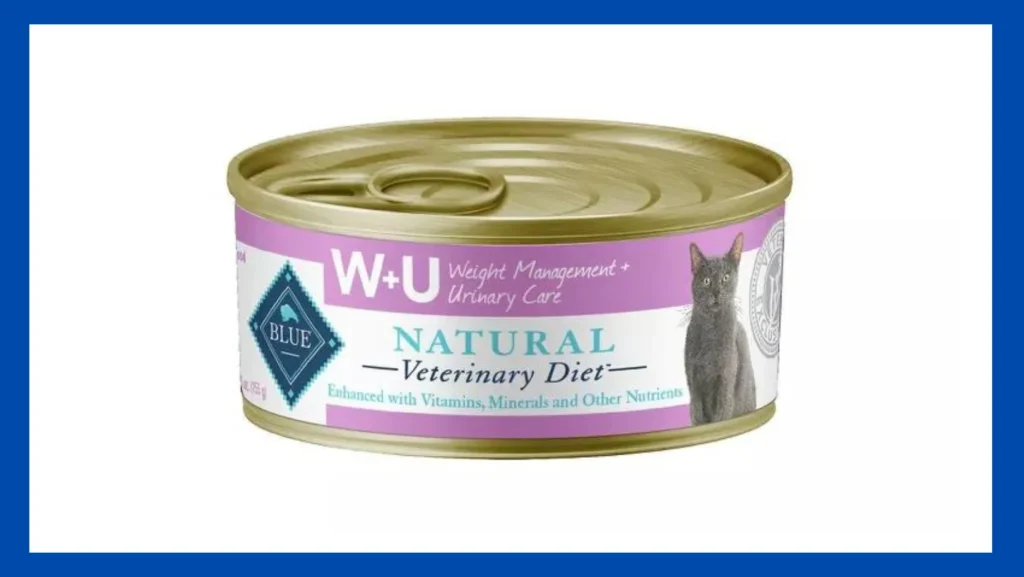
Senior cats who get less active with age may struggle with obesity, particularly if they live inside exclusively or have health issues that limit their mobility or energy. It makes sense to think about a food that offers optimal levels of fat, calories, and fiber to help your cat manage its weight as well as controlled mineral levels to keep urine pH lower to prevent crystal and stone formation since some urinary problems are more common in senior, overweight, and/or obese cats.
Blue Buffalo W+U Urinary health Care and Weight Management Many veterinarians recommend canned wet food as a great option. In addition to having chicken as the main ingredient, this food also contains plant fiber in the form of powdered cellulose, which helps your cat feel fuller even if it contains fewer calories. Controlled salt and magnesium levels provide a pH equilibrium in the urine.
According to Blue Buffalo, a group of PhD veterinarians, food scientists, and animal nutritionists create the company’s scientific formulae.
Key Ingredients: Pea protein, potatoes, whitefish, carrots, cranberries, chicken, chicken broth, and liver. Serving size: half a can (68 calories) | Balance: minimum 8.5% crude protein, minimum 2.5% crude fat, maximum 4% crude fiber, maximum 78% moisture | Life Stage: adult, senior | Texture: paté
Best Non-Prescription Wet: Purina Pro Plan Urinary Tract Health Canned Cat Food
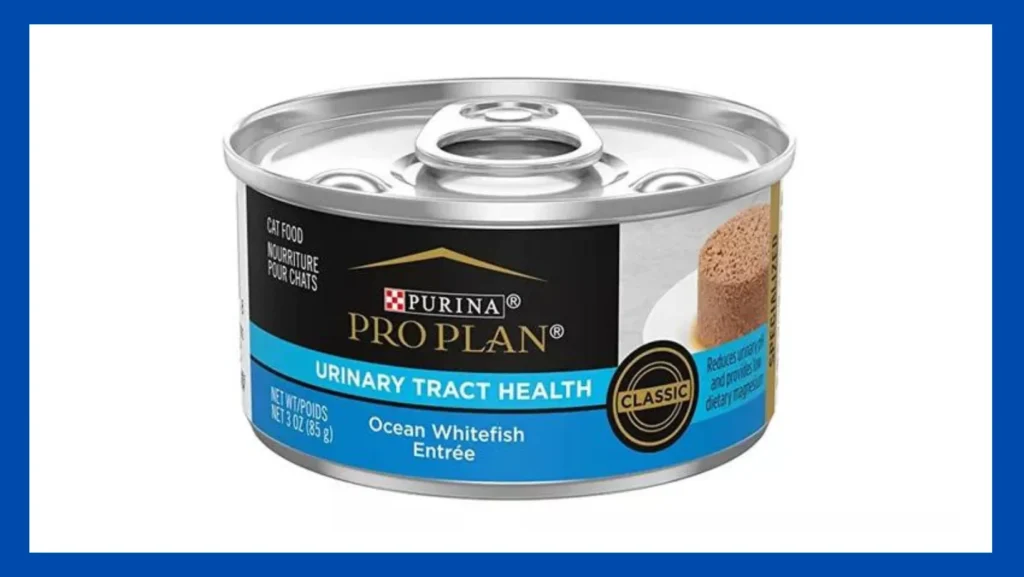
Focus Classic Urinary Tract Health Formula by Purina Pro Plan The five nutrient-dense flavors of Adult Wet Cat Food are Ocean Whitefish, Beef and chicken, Chicken, Turkey and giblets, and Salmon. The formula’s low dietary magnesium content lowers urine pH and contributes to the stability and integrity of a cat’s urinary system. The food is accessible without a prescription and is appropriate for adult cats. Additionally, it is easily accessible at numerous stores and is produced in the United States. While actual fish or animal protein is used in each dish, animal byproducts are also a major component.
Key Ingredients: Chicken By-Products, Water, Beef, Rice, Guar Gum, Tricalcium Phosphate, Potassium Chloride, Zinc is Ferrous Sulfate, Manganese Sulfate, Copper Sulfate, Potassium Iodide, Salt, carrageenan Taurine, Iron Oxide as a Color, It Chloride (Varies by flavor) | Calories per Served: 82 to 107 (half can) depending on the flavor | Texture: Wet, varies | Balance: Variables but most are Minimum 10.0% crude protein, minimum 6.5% crude fat, maximum 0.5% crude fiber, maximum 78.0% moisture | Life Stage: Adult
Best Variety: Tiki Cat Aloha Friends Variety Pack Grain-Free Wet Cat Food
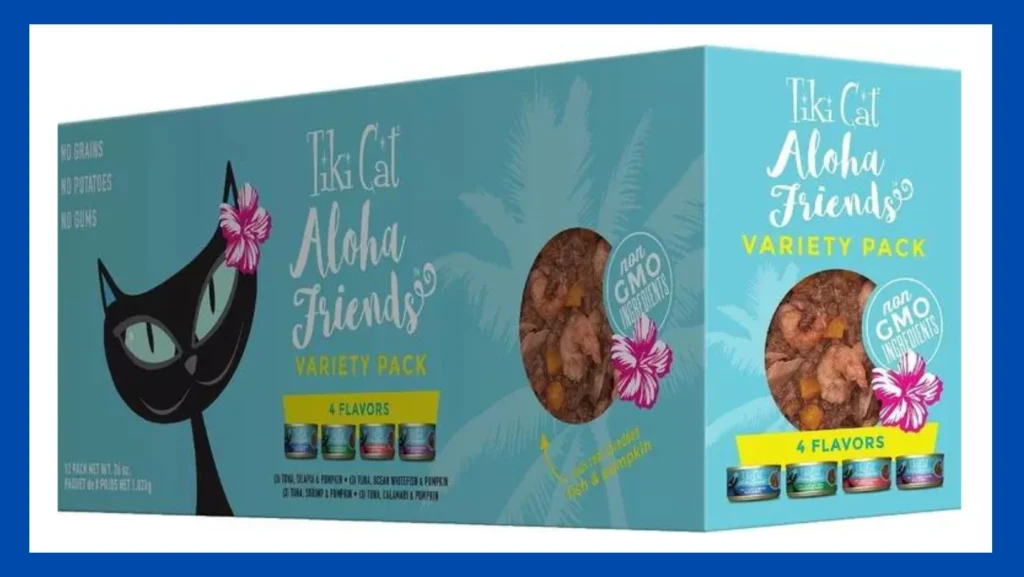
Giving a cat a wider variety of flavors and nutrients can be done easily with the Tiki Cat Aloha Friends Variety Pack Grain-Free Wet Cat Food. This variety pack’s four flavors—which include fiber, antioxidants, and moisture to support urinary health—offer comprehensive and well-balanced nourishment. All of the dishes start with wild-caught tuna, which has been mercury-tested and deemed safe for dolphins.
The shredded texture of the grain-free recipe is combined with broth. Each serving in a can or pouch contains taurine, vitamins, minerals, and omegas to support healthy digestion while also nourishing your cat’s skin and coat.
Important ingredients: Zinc sulfate, vitamin B1, vitamin B3, calcium pantothenate (varies per flavor), flaked tuna, tuna broth, pumpkin, tilapia, sunflower seed oil, calcium lactate, tricalcium phosphate, choline chloride, taurine, vitamin E supplement. | 57–60 calories per serving (depending on the flavor) Balance: Minimum 11% crude protein, Maximum 1.8% crude fat, Maximum 0.5% crude fiber, Maximum 83% moisture, Maximum 0.08% magnesium, Maximum 1.5% ash, Maximum 0.2% taurine | Life Stage: All | Texture: Shredded
Best Supplement: Under the Weather Urinary Support Soft Chews for Cats
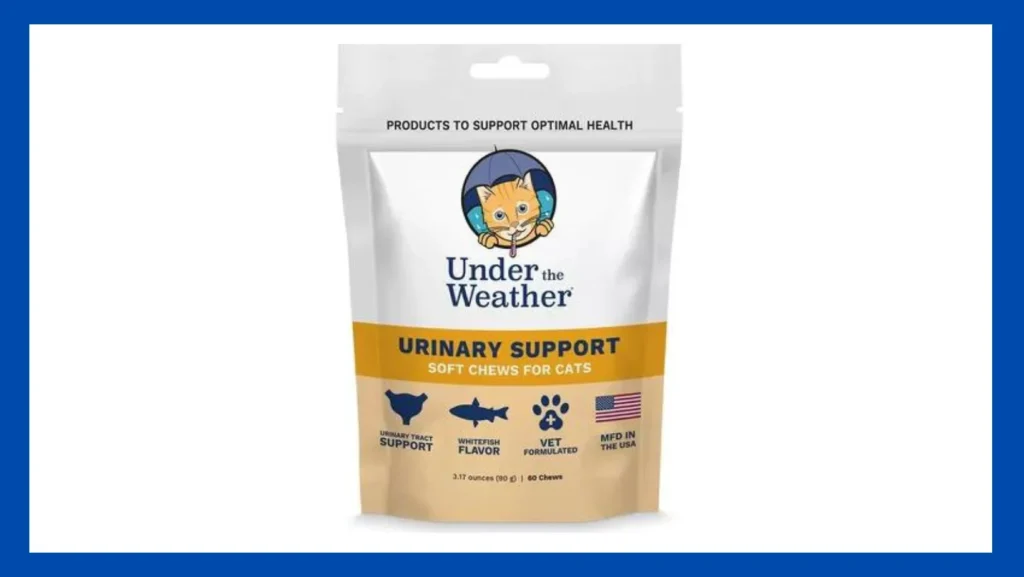
While the majority of cat meals for urinary health are made to provide your cat with all the nourishment they need without the need for supplements, you can use an extra supplement in addition to non-prescription foods to help steer your cat’s health in the right direction.
Among the many supplements produced by this company is Under the Weather Urinary Support Soft Chews for Cats. The components include cranberry extract and D-mannose, which support normal urinary tract health, as well as N-acetyl glucosamine, which maintains a good pH balance in the urinary system.
Common sugar D-mannose has been demonstrated in human and animal studies to help prevent bacteria from adhering to the bladder and urinary system, hence lowering the risk of bacterial urinary tract infections and preventing their recurrence.2.
De Nunzio C, Simonato A, Ficarra V, Tubaro A, Bartoletti R. The current status and potential future directions of D-mannose’s role in preventing recurrent, simple cystitis. 2021;10(4):373; doi:10.3390/antibiotics10040373. Antibiotics (Basel).
This supplement is veterinarian-formulated, made in Vermont, and devoid of maize and artificial flavors and dyes. An added plus is that a percentage of every transaction is given to the Ruffy Rescue Fund, which helps with pet transportation to Vermont for adoption as well as spaying and neutering in overcrowded American areas.
Essential Components: D-mannose, cranberry extract, N-acetyl glucosamine from shrimp and crab, balance, calories per serving, life stage, and texture: soft chews
What to Consider in a Cat Food for Urinary Tract Health

Consider carefully reading labels to determine which brand is best for your feline. According to Dr. Danielle Bernal, a Global Veterinarian with Wellness Natural Pet Food, “pet parents should first work with their veterinarian on what their cat specifically needs.” “Key characteristics that the cat parent should look for to support their cat’s urinary tract health can be provided by a veterinarian.”
Texture
In the wild, a cat would consume a variety of foods with different textures and devour fresh meat to obtain a large amount of water. They might have an innate tendency toward wet and uncooked meals as part of their preferences. However, just like people, domesticated cats have their tastes, so make sure to take that into account. Some people might want their meal chunky or softly minced. Keep an eye on your cat’s food. Is their food licked by them? Do they start with the gravy? You may be able to infer their preferred texture from their habits. Throughout the week, most veterinarians advise giving your pet a combination of wet and dry food.
Raw food, a relatively new trend in pet food, is claimed to be the best option because heat does not deteriorate proteins and other vital components. Raw foods do, however, also raise the risk of bacterial illnesses such as salmonella and Listeria, which can cause vomiting, diarrhea, and ultimately a nervous system infection. Before attempting a strictly raw food diet, make sure you do your homework and speak with your veterinarian.
Ingredients
Make sure your cat food is labeled “Made in the USA” if you reside in the United States. Country-specific pet food production standards differ greatly. After being examined, a large number of foods made in other nations were shown to have dangerously high quantities of heavy metals and even plastic additives.
Protein, fat, fiber, and moisture percentages are included in the component list, which is arranged from most to least depending on weight, just like in ingredient labels for human food. Start your search for items that offer a high protein level for a particular animal. If there are any grains listed, whole grains are the greatest option due to their high vitamin content.
It’s also critical to consider the food’s nutrient value, moisture content, and fat level. Cats are largely carnivorous since they are hunters by nature. They would eat prey that is mostly composed of protein, with moderate fat content and only small amounts of carbs. So keep an eye out for foods that could add to obesity by having too many carbohydrates. Whole grains like brown rice, sweet potatoes, and organic pumpkin are good sources of healthy carbohydrates.
It should be noted that dry food percentages are provided on a dry basis, but wet food percentages are presented on a wet basis and contain a large percentage of water. As a result, protein and fat content numbers in dry foods will be higher than in wet foods. In wet foods, you should aim for a minimum of 8 to 10 percent protein or at least 25 percent in dry food. In wet food, the minimum fat level should be 5%; in dry food, it should be between 20 and 30 percent. Certain cats will reject meals that have less fat or protein than is advised.
In-store brands and manufacturers utilize natural preservatives to prolong shelf life and prevent rotting. Vitamins C (ascorbic acid) and E (tocopheryl or tocopherol acetate) are examples of non-synthetic preservatives.
Other Nutrients
In addition, cats need around a dozen other nutrients, such as minerals, fatty acids, vitamins, and amino acids. Every stage of life, from kitten to adolescent, during pregnancy and lactation, and as an elderly cat, has different nutritional requirements. Your cat won’t need any extra vitamins if their existing diet is complete and well-balanced for their stage of life.
Organic
You should read the fine print because, as you may know, the phrase “organic” can be applied in a variety of contexts. The term “organic” in cat food is governed by the U.S. Department of Agriculture (USDA). The USDA is required by law to regulate cat food according to the same regulations as human food. The term “organic” describes the methods used to grow, raise, and care for an animal or crop. Growing organic crops requires at least three years of pesticide-free land. The food itself must be free of antibiotics, genetically modified organisms (GMOs), artificial flavors, colors, and preservatives, as well as hazardous and persistent pesticides and radiation.
Organic animals must be provided organic feed, not be given hormones or antibiotics, and have access to the outdoors if their meat is used in pet diets. All of these conditions must be met in writing and verified by a USDA inspection to obtain USDA certification. You cannot be certain that the food is organic until it is labeled as “USDA Certified Organic.”
You’ll also notice a percentage on the label, such as “95% USDA Certified Organic,” if only a part of the ingredients come from certified organic sources.
Natural
Comparably, the term “natural” for pet food and animal feed is defined and governed by the Association of American Feed Control Officials (AAFCO). “Natural” refers to feed or ingredients that come exclusively from plant, animal, or mining sources and aren’t made via the use of chemicals or artificial processes. Nevertheless, several substances may bear the term “natural” even though they aren’t beneficial or healthful for your pet.
Grain-free
The grains we’ve introduced into the domesticated diet of cats did not evolve for them to eat. Allergies and stomach issues have been linked to barley, wheat, corn, and rice. Additionally, they encourage higher pH and more alkaline urine. Watch out for inexpensive, low-nutrient components that are referred to as “fillers.” They are added with fewer premium ingredients by weight to help your pet feel full. Common ones include grain products made from corn and wheat gluten, soy, animal byproducts, and pulps from fruits and vegetables.
Probiotics
Pre-, post-, and probiotics are also added to a lot of brands to support a healthy gut and intestinal flora, which lowers inflammation, boosts immunity, and maintains a healthy urinary tract. Cats that are domesticated and do not consume rodents or other naturally occurring animals are not exposed to the same microorganisms that they would in the wild. Therefore, if you have the choice, take pre-, post-, and probiotics for your cat, especially if they have a sensitive stomach or have just taken antibiotics or other treatments.
Maybe Useful
FAQs:
What should I look for in cat food for urinary health?
Make sure it’s high in moisture, low in magnesium, and contains high-quality protein sources.
Can I prepare homemade food for my cat’s urinary health?
To be sure your homemade meals are meeting your cat’s nutritional needs, speak with a veterinary nutritionist.
How often should I feed my cat this special diet?
Observe the feeding recommendations made by your veterinarian or the guidelines supplied by the cat food manufacturer.
Is dry or wet food better for urinary health?
As it encourages hydration, which is essential for urinary health, wet food is recommended.
Can urinary health issues in cats be solely managed through diet?
Diet is important, but so are routine veterinary exams and adequate water.
Are there specific brands known for their urinary health cat food?
Yes, there are respectable companies that focus on making cat food specifically designed for urinary health. Do careful research or ask your veterinarian for advice.
What ingredients are different in cat food for urinary tract health compared to regular cat food?
By raising your cat’s urine pH, cat food designed specifically for urinary health limits the levels of minerals like calcium, phosphorus, and magnesium that can cause urinary crystallization and stone development. Since crystals develop more easily at higher urine pHs, the diets are designed to make your cat’s pee mildly acidic (low pH).
Do you need a prescription from the veterinarian for the best urinary tract health cat foods?
“As urinary tract problems can be complicated conditions, it’s important to discuss treatment options and dietary recommendations with your veterinarian. Dr. Bernal says, “It’s a common recommendation to feed more wet food for cats to support urinary tract health by boosting hydration, although your veterinarian can prescribe a specific diet.” When it comes to increasing hydration, premium wet cat recipes like Wellness Natural Cat Wet Foods are a fantastic place to start. You can find these diets at most pet stores.
Why do some foods require a prescription and others don’t?
According to Dr. Bernal, prescription diets are therapeutic nutritional plans that help treat acute or long-term medical conditions. “Prescription diets make sure that the pet receives veterinarian treatment and is fed food that supports underlying health conditions and targets nutrients for the right amount of time. Some diets don’t need a prescription because they are intended for healthy pets.
Conclusion
Your cat’s health needs to select the Best Cat Food For Urinary Health Without Vet Prescription. To maintain a healthy urinary system, give top priority to high-quality products, sufficient water, and a balanced diet. Your cat can live a full and active life if given the proper nutrition and care.
